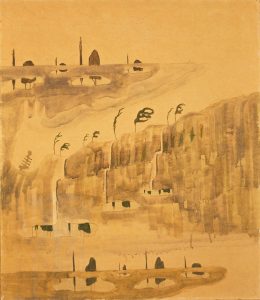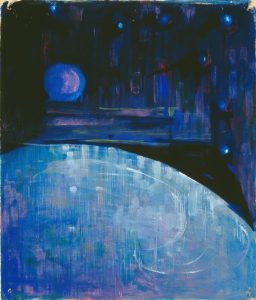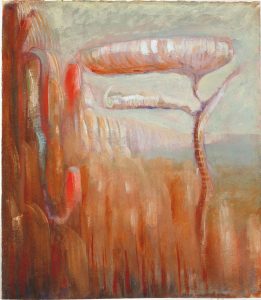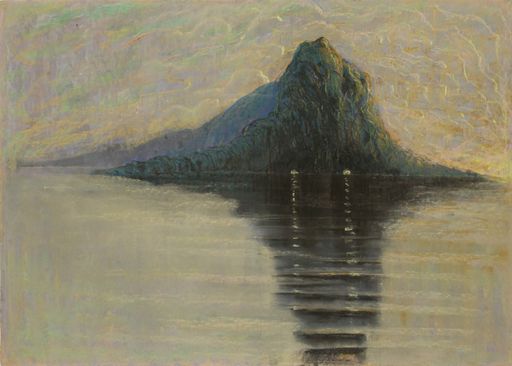Čiurlionis: How Does the Work of This Modernist Genius Inspire Us Today?
In the annals of European art history, some visionaries remain unjustly overlooked. As we approach 2025 and the 150th anniversary of his birth, Mikalojus Konstantinas Čiurlionis stands out as a creator of extraordinary versatility whose artistic innovations were years ahead of their time. His pioneering synthesis of music and visual art, coupled with his deep interest in philosophy, cosmology, and ancient cultures, created a legacy that continues to challenge and inspire in the modern world.
A Prodigy’s Path: From Music to Visual Arts
Born in 1875 as the eldest of nine children to a church organist, Čiurlionis showed remarkable musical talent from an early age. A child prodigy who mastered piano by age five and organ by six, he went on to study music in Warsaw and Leipzig. However, his creative journey took an unexpected turn when he discovered painting and enrolled in the Warsaw School of Fine Arts. During his tragically short lifetime – he died of pneumonia in 1910 at just 35 years old – Čiurlionis created an astounding body of work: 400 musical pieces and 300 ethereal, occasionally fantastical paintings that challenge the boundaries between both art forms.

“When we look at Čiurlionis, the first concept that comes to mind is universalism,” explains Antanas Andrijauskas, an academic and renowned Čiurlionis scholar. “Čiurlionis not only expressed himself in the fields of painting, music and literature but also encoded in his works a universal humanist approach to the world, characterized by an awareness of the importance of the cultural heritage of all civilizations. In his paintings, we find symbolic meanings from different cultures, combined to outline the contours of a highly harmonious world.”
What made Čiurlionis truly revolutionary was his unique approach to combining music and visual art. “Unlike artists before him, who understood musicality as an external representation of musicians or instruments, Čiurlionis took a completely different approach,” Andrijauskas notes. “He developed a complex spatial and temporal internal architectonics of painting.” This innovation manifested in his creation of new art forms – pictorial sonatas and fugues – that were more sophisticated in terms of artistic form than the synaesthetic works of other early twentieth-century masters.
A Pioneer Ahead of His Time
His artistic evolution was remarkably swift. “Čiurlionis’s creative path was very short – just six or seven years – but there is a gulf in quality between his early and late works,” Andrijauskas observes. “It is incredible that such a leap in plastic form can be made in such a short time.” While his early work showed influences of Symbolism, he quickly transcended these beginnings to explore new territories.
Andrijauskas emphasizes Čiurlionis’s pioneering role in multiple artistic movements: “Čiurlionis stands not only at the origin of abstraction but also of poetic surrealism and metaphysical painting.” By 1906/7, he was already producing abstract paintings and works close to poetic surrealism, preceding many of the modernist movements that would later define 20th-century art. In his final period, he was creating metaphysical paintings, a style that would later be developed by Giorgio de Chirico. “Čiurlionis’s work, as the unknown facts and testimonies I have uncovered show, also undoubtedly influenced Wassily Kandinsky, who is generally credited as one of the pioneers of abstraction in Western art,” Andrijauskas adds.

Lost and Found: The Journey to Recognition
Yet, despite his innovative genius, Čiurlionis remained relatively unknown in Western art circles for decades. “After his 1910 exhibition in Paris and posthumous retrospective exhibitions in 1912 in Vilnius, St. Petersburg, and Moscow, as well as participation in the Second Post-Impressionist Exhibition in London, 1912-1913, famous Russian art critics proclaimed him a genius,” Andrijauskas notes. “However, due to the World Wars, the Soviet occupation, and Stalinist terror, Čiurlionis’s works were not shown in any significant exhibition abroad for almost 70 years. This means that during the period when the history of modernism was being written, his originals were simply inaccessible to Western art critics and researchers.”
Andrijauskas reflects on what might have been: “Čiurlionis is an artist with a cursed fate: had he sent his painting to the New Artist’s Association exhibition in 1910, as Kandinsky asked him to, he would have already been written into the history of modern art. This exhibition featured world-class artists like Picasso, Braque, and Delaunay. However, by then, Čiurlionis was already seriously ill.”
Today, this historical oversight is being corrected. Daina Kamarauskienė, Director of the M. K. Čiurlionis National Museum of Art, notes a growing international recognition: “Curators from various museums who visit Lithuania are often surprised and embarrassed that they didn’t know about Čiurlionis before.
While we can blame the Iron Curtain for preventing Čiurlionis from being properly established as a significant part of European culture, this process is finally taking place, albeit belatedly.
Inspiring New Generations
The artist’s appeal reaches well beyond traditional art circles. Young composers continue to find inspiration in his work. “Čiurlionis’s music is not only aesthetically beautiful but also intellectually profound, inviting us to rethink traditional forms,” says Domantas Pūras, a recent recipient of the M.K. Čiurlionis scholarship. In his album, Like an Underground River, Pūras blends Čiurlionis’s music with elements of contemporary electronic and experimental music.

Through such contemporary interpretations, Čiurlionis’s work continues to speak to new generations of artists and listeners. As Pūras notes, “Čiurlionis’s music often evokes a sense of journey, of the unknown, of transcending space and time. This resonates well with modern man, who is also on a constant quest for identity and meaningful answers in a global world full of information overload.”
A Universal Legacy
Perhaps most significantly, Čiurlionis’s work speaks to contemporary concerns about humanity’s relationship with the natural world. “He emphasized what is particularly relevant today in the context of universal harmony of humanity and the pressing ecological issues we face: the harmonious relationship between man and the natural world,” Andrijauskas points out. “This is one of the most important leitmotifs of his work, stemming from his deep connection to the nature of his homeland.”
While few tourists travel solely to visit an artist’s homeland, cultural figures often become powerful symbols that add to a destination’s appeal and memorability – Prague has become inseparable from Kafka, Georgia from Pirosmani, and Greece from Kazantzakis. Similarly, Čiurlionis and his visionary art can serve as a gateway to understanding Lithuania’s creative spirit, creating a distinctive cultural touchpoint that helps visitors form a deeper connection with our country.”
This blend of universal appeal and strong cultural roots makes Čiurlionis increasingly relevant in today’s globalized world. As Olga Gončarova, Head of Lithuania Travel, explains, exploring Čiurlionis’s work could be an experience that resonates deeply with contemporary travellers: “Recent travel market research shows that for the majority of travelers, authentic experiences are a key factor when choosing their next destination. Čiurlionis’s work, an important part of Lithuania’s rich cultural heritage, embodies this authenticity and speaks to our search for meaningful cultural experiences.
The artist’s legacy continues to grow. Recent years have seen exhibitions in France, Italy, Spain, the UK and the Netherlands, with particularly strong interest from Japan. “The Japanese were the very first to host an exhibition of Čiurlionis’s paintings abroad in 1992,” Kamarauskienė notes. “In 2026, we’ll have another chance to have a Čiurlionis exhibition in Japan, at the National Museum of Western Art in Tokyo.”

New aspects of his work are still being discovered. “From whatever angle you look at Čiurlionis, you always discover something new,” says Kamarauskienė. “It’s a shame that so little of his literary work has survived, but it’s wonderful that recent exhibitions have showcased his previously unexplored work in photography, adding another dimension to his already impressive legacy.”
As we approach his 150th anniversary in 2025, Čiurlionis’s vision of artistic synthesis and universal harmony feels more relevant than ever. In a world often divided by conflict and environmental crisis, his work offers a compelling reminder of art’s power to unify and inspire across cultural boundaries while remaining true to its roots. As Andrijauskas concludes, “In Čiurlionis’s works, the local naturally blossoms into the universal – a lesson in itself in a time of cultural leveling and erasure of identities.”
- Sonata II (Sonata of the Spring). Allegro. 1907, Tempera on Paper ↩︎
- Creation of the World.III from the cycle of 13 paintings. 1905. Tempera on Paper ↩︎
- Creation of the World. VII from the cycle of 13 paintings. 1905, Tempera on Paper ↩︎
- Serenity. 1904. Pastel, Charcoal ↩︎
Original article is published on Lithuania.lt
Rėmėjai

